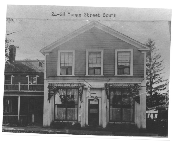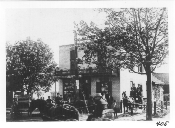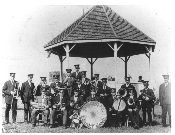Table of Contents
|
Between Old and New
The
new arena, the
waterworks system, and
the modern
high
school were all very impressive but they were expensive to build. The
details of their cost and construction provided fodder for discussion over back
fences and around dinner tables in
Richmond Hill through
the 1920s. Yet in each case, the proponents of the new persuaded council
members and ratepayers that such improvements and upgrading were necessary to
complement a postwar twentieth-century community.
 |
| The
Rustic Inn on the
west side of
Yonge Street at
Nos.
24-28
South. The business was begun by
Daniel Stong in
the 1920s, and continued by his daughter and son-in-law,
Ethel and
James Wigmore,
as an ice cream parlour, restaurant, and boarding house. |
 |
| F.E. Sims
General Store on the east side of
Yonge Street,
north of the radial railway station. |
 |
| Interior view of the
F.E. Sims
General Store. |
With the floral industry still providing a major impetus,
Richmond Hill
continued to grow during the 1920s. Population jumped more than 20 per cent
during the decade, from 1055 to 1295. Older homes were renovated and new houses
built on recently opened streets on the east and west sides of town. There was
plenty of commercial activity along
Yonge Street, as new
stores and businesses moved in to replace old ones that had expired. Along the
highway itself, cars, trucks, and buses had all but eliminated the horse and
buggy and were even challenging the radial railway for supremacy.
 |
| The
Innes Mill at the
west end of
Richmond
Street, south of the
Mill Pond, in the
1920s. |
 |
| Employees of the
Innes Mill in the
1920s. Standing are, left to right:
- Denby,Isill Tyndall,- Rikey, -,
Carnie Marsh,- Neal,Bert Meek,George Sims,Jim Wigmore,Will Innes.
Seated:
Harry Innes, -,
- Teatzell,Teatzell, -, -
- Hopper,Bert Bennett,Harry
Leach. |
Alexander (Alex)
Hume recorded many of these changes in the village council minutes. Hume
had replaced
Matthew Teefy as
municipal clerk in 1905 and held the job for the next thirty-seven years. Born
in Glasgow, Scotland, in 1858, Hume arrived in
Richmond Hill in
1879, where he established a tailoring business and soon became involved in the
community as a
Methodist Sunday
School teacher, private music teacher, and leader of the
Richmond Hill
Band. But, like his predecessor,
Hume became so
closely identified with his work as village clerk that many residents believed
he - not the reeve and councillors - ran the council.
 |
| Leslie and
Mary
(Ritchie) Innes on their 50th wedding anniversary, May 8, 1907, in front
of their home at 124
Richmond Street,
with their three sons, left to right,
Alexander
Ritchie Innes,John Leslie
Innes, and
William
Innes. |
Council still contended
with the age-old duties of appointing officials, setting salaries, listening to
complaints, determining mill rates, and collecting taxes. But much more was
happening in the 1920s - the financing of public works projects, responding to
public health concerns, switching from a private electrical power supplier to
the
Hydro-Electric Power Commission of Ontario. The offices
of clerk, reeve, and councillor demanded more time and attention now, as
regular monthly meetings were frequently supplemented by special meetings.
 |
| Leslie Innes
quotes on materials for the
Richmond
Hill Public Library. |
In spite of all these new issues, however, council still
had to deal with a recurrent headache left over from the previous century -
what to do about the fire brigade. True, a modicum of stability had been
enforced on the fire-fighting scene in the 1880s, and subsequent blazes were
quelled without a repeat of the major disasters of the 1860s. But by the
beginning of the
First World
War, with dwindling ranks of volunteers, ineffective leadership, and
outdated equipment,
Richmond Hill's
volunteer fire brigade was again proving an embarrassment to the
community.
11
 |
| The
Richmond
Hill Cornet Band. |
Finally in 1924, council requested advice from
Harold
Mills, one of
Richmond Hill's major
greenhouse operators.
Mills suggested major improvements to fire-fighting
procedures and the purchase of a motorized fire-truck and other modern
equipment - in short, the transformation of a volunteer brigade to a
semi-professional force.
12 Council was so impressed by these
recommendations that it appointed
Harold
Mills as fire chief.
Mills accepted and then persuaded many of his greenhouse
employees to volunteer their services as firefighters. And so, once more, the
rose growers came to the rescue of
Richmond Hill.
Notes
11.
Minutes of Village Council,May 9, 1917;June 12, 1918;July 11, 1918.
12.
The Liberal,March 13, 1924.
Previous
Next
Copyright © Richmond Hill Public Library Board, 1991
|

